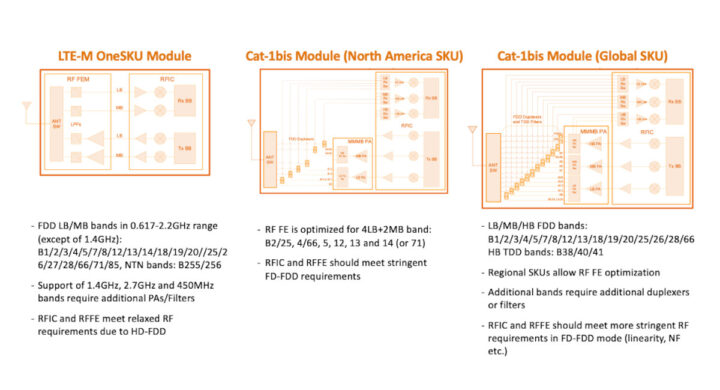CNXSoft: This is a guest post by Dana Cohen, Product Marketing Manager at Sony Semiconductor Israel, discussing LTE-M in asset trackers and comparing it to LTE Cat1.bis, another LPWAN technology.

Connectivity has been a game changer in the asset-tracking landscape. Personal devices, pets, vehicles, international packages, or any kind of asset can all easily be tracked through the cloud. This has opened the door to innovative use cases that have transformed global shipping, automotive loans, retail management, construction, and other industries.
Using asset trackers allows shippers to track the temperature and condition of products and raw materials as they move on ships, planes, and trucks through the supply chain. Families have a better chance of recovering beloved pets that are lost. Even banks are more willing to approve high-risk car loans, knowing that they can locate and recover a vehicle if its owner falls behind on payments.
While there is some debate as to the best connectivity technology to integrate into the tracker, the benefits introduced by LPWA (low-power wide-area) have placed it as the frontrunner. LPWA technologies are optimized for low-power, long-range communications, making them ideal for tracking applications with extended battery life and broad coverage requirements.
LTE-M, a form of LPWA technology, has demonstrated its value in terms of cost, coverage, power consumption, and longevity. It offers a number of benefits over other cellular solutions, such as Cat 1bis. This article will focus on the coverage and hardware advantages offered by LTE-M.
What is LTE-M Connectivity?
Long-Term Evolution for Machines, better known as LTE-M, is a versatile connectivity solution that extends the capabilities of LTE networks to support IoT applications. LTE-M offers superior coverage, better signal penetration, improved power efficiency, and other benefits, all of which support its case as the most effective connectivity solution for asset trackers.
LTE-M is governed by standards set by 3GPP. As a result, it is included in 5G and is effectively future-proof for the next 15 years or more. Since 2017, the number of LTE-M networks has dramatically grown, and by 2023, there were over 115 mobile network operators that supported the protocol. Effectively, LTE-M (and NB-IoT) is directly supported in North and South America, Europe, most of Asia, Australia, and more.
Comparing LTE-M and CAT 1bis Hardware
Cat 1bis is a comparable technology sometimes used in connecting devices. It is a low-cost version of the CAT-1 chip, containing only one antenna. It is ideal for low-cost IoT devices that don’t need the complexity of a MIMO antenna found in CAT-1 chips, but want to utilize LTE networks with higher data rates. Cat 1bis is also used for applications that require higher throughput. Devices that involve voice transmissions or require real-time, two-way communication such as routing updates are better served with the faster communication capabilities of Cat 1bis.
However, Cat 1bis chipsets introduce a hardware/coverage challenge. These chips use a Full-Duplex Frequency Division Duplex (FD-FDD). FD-FDD operation mode has simultaneous transmission and reception on two different frequency bands. These bands vary between regional networks due to regulatory requirements, and the duplex gaps are different in each region. As a result, each chip needs to be built for a specific regional network. As shown in the following figure, a manufacturer developing a tracking product that will be sold globally must develop and install chips for each region. Building a global Cat 1bis SKU increases the hardware components within the chip and might add up to $4 to the cost of the chip (Out of China prices).
LTE-M chipsets, on the other hand, have a Half Duplex Frequency Division Duplex (HD-FDD) operation mode. This means they are unable to simultaneously transmit and receive data, and it also allows for more simplicity on the hardware side, in terms of supported frequency bands: LTE-M has one global SKU design. As a result, it can connect with any network operator that supports 4G or 5G. This simplifies manufacturing as developers can create a design with a single chipset model and deploy it globally.
This differentiation takes on greater importance with trackers. As items sometimes move from one country or region to the next, those devices being monitored by a Cat 1bis need to be initially designed with specific region SKUs or global SKUs. Packages, shipments, and other devices using an LTE-M chip can still be monitored wherever they go.

LTE-M has several other advantages over Cat 1bis which make it ideal for tracking devices. It has a longer battery life, ensuring that users can track the device for a longer period of time. This takes on greater importance when items are being tracked and monitored over a long period of time.
LTE-M also has better network coverage and signal penetration than Cat 1bis. Testing has shown that LTE-M can maintain connectivity at coupling losses of up to 154 dB. Cat 1bis loses connectivity at 145 dB. This means LTE-M maintains connectivity in areas with poor network coverage and gains 9dB compared to Cat 1bis. This reliability is important in tracking, where objects being tracked with an LTE-M chipset will continue to transmit their locations even in poor coverage areas.
The Future of Asset Tracking Global Connectivity is LTE-M
The choice of connectivity technology plays a decisive role in the success of tracking assets anywhere in the world. LTE-M’s versatility and ability to operate seamlessly across regions make it an obvious choice, as organizations don’t have the concern of losing connectivity.
This level of reliability allows businesses to monitor their assets in remote locations, harsh conditions, or densely populated urban environments with the same confidence. As these technologies evolve, the balance between cost efficiency, global scalability, and operational performance will further solidify LTE-M as the dominant choice to track assets.

Jean-Luc started CNX Software in 2010 as a part-time endeavor, before quitting his job as a software engineering manager, and starting to write daily news, and reviews full time later in 2011.
Support CNX Software! Donate via cryptocurrencies, become a Patron on Patreon, or purchase goods on Amazon or Aliexpress




